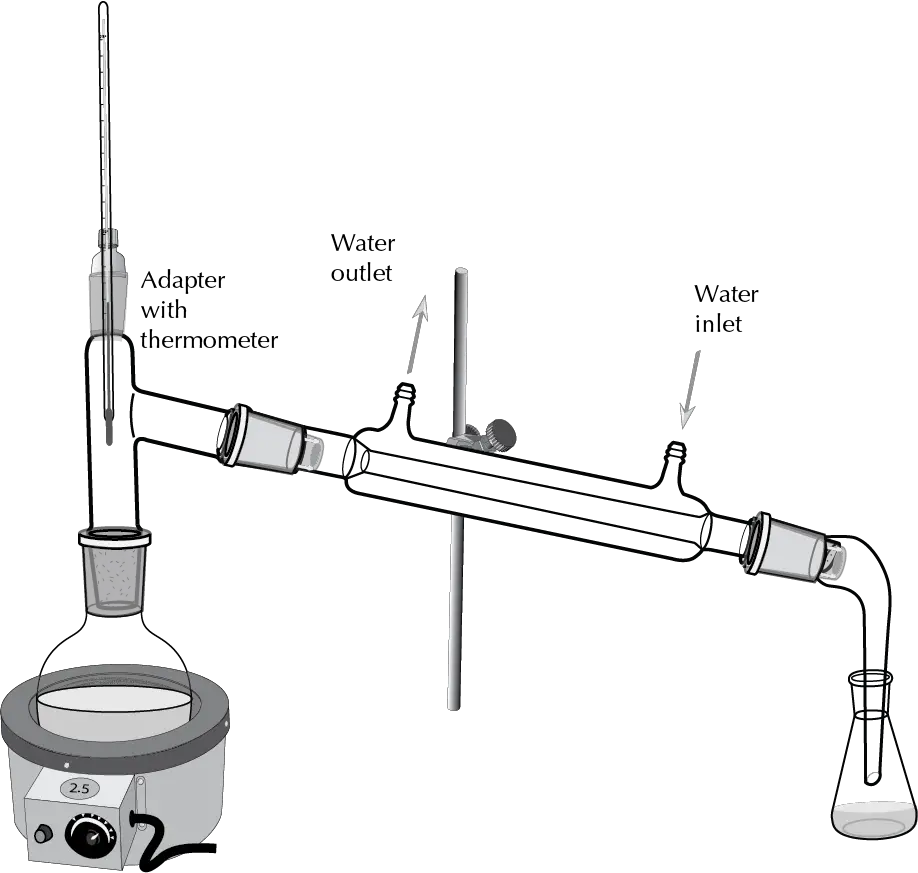Written by J.A Dobado | Last Updated on April 22, 2024
What is the simple distillation?
La simple distillation is a separation technique used in chemistry laboratories to purify liquids through the removal of impurities non-volatile. It is also used for the separation of mixtures of liquids miscible that differ in b.p. in at least 25 °C.
The process is governed by the Raoult’s law.[1] The most common configuration to perform the distillation is illustrated in the Figure. You need a distillation flask with a ground-glass mouth, a distillation head, a thermometer, water condenser (ie. Liebig condenser), a distillation adapter, and a receiver flask.
Simple distillation assembly
The set of parts must be fixed by clips, clamps and nuts fixed to a wire rack. You must ensure that all fasteners are tight. It is usually placed two clips one at the mouth of the round-bottom flask and another in the water condenser. The assembly is secured with two clips to the ends of the water condenser.
- Can be used as a source of heat, a heating plate with or without magnetic agitation.
- To ensure homogeneous boiling when heating, we must use 1 or 2 pieces of boiling chips or a stir bar (in the case of plates that include magnetic stirring).
- The distillation head allows you to place the thermometer and divert the steam to the water condenser.
- All the pieces are connected due to the fact that their ends occur together of ground glass.
- The thermometer should be placed with its bulb below the lower level of the lateral line of the connector distillation that is in the current of steam distillation and the measurement is correct.
- Finally, the rubber tubing is connected to water condenser to provide the water (inlet from water supply, lower end, and outlet to sink, upper end).
Simple distillation setup

As the solution is heated and reaches the boiling point of the component is more volatile, some of the molecules of this pass to the gas phase and up to the condenser.
The condenser is a tube made of glass with sections, internal and external, separate. The steam passes through the inner section of the condenser, where it condenses into a liquid by cold water flowing in the outer section of the condenser. This condensed steam is called the distillate is collected in a container Beaker or graduated cylinder.
As the distillation progresses, the temperature required to boil the dissolution increases, due to that, it will disappear the component is more volatile boiling before. Therefore, the composition of the distillate varies with time. At the beginning of the distillation, the distillate is rich in the component is more volatile; in the middle of the distillation, the distillate contains a mixture of the two components, and in the end, the distillate obtained is rich in the component is less volatile.
Video on simple distillation
References and notes
- [1] The vapor pressure of part of each component of an ideal mixture of liquids is equal to the vapor pressure of each component is pure multiplied by its mole fraction in the mixture (additional information).
- Isac-García, J.; Dobado, J. A.; Calvo-Flores, F. G.; and Martínez-García, H. (2015). Experimental Organic Chemistry Laboratory Manual. Elsevier Science & Technology. ISBN: 978-0-12-803893-2